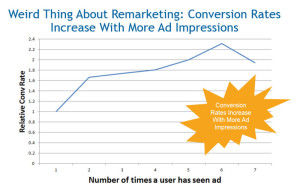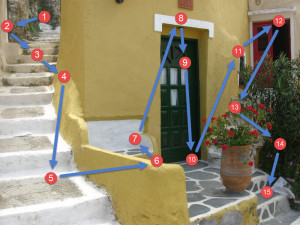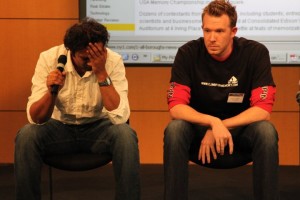Free Ad Impressions Through Mnemonics
Frequency is a key element of campaign design, especially in retargeting efforts. Multiple touches usually do better than one-off messages. But additional impressions will increase the rate of spend too. It’s a balancing act to find an efficient rate of spend and a satisfactory return on investment.

That’s if you’re paying for additional impressions. It works better if you can get them for free.
While adding external impressions will increase costs, mental repetitions are free. By developing creative specifically designed to enhance recall, you can increase the returns on your campaigns without breaking the budget.
Mental recall by design
There are myriad techniques for improving recall including classic advertising tactics like repetition and setting slogans to music. For more creative ideas, and to get the most drastic effects, we can look to memory champions and the mnemonics they use.
Each year the top mental performers in the US gather to compete in the USA Memory Championships. Performing feats of memorization such as recalling entire blocks of poetry upon a single exposure to it and committing hundreds of digits of random numbers to memory, they use mental tricks to help enhance recall. Our target audiences may not be focused on memorizing details but we can still employ some of the techniques used.
There are a lot of techniques that competitors use to store and recall large amounts of random information. One of the popular and effective is the Method of Ioci or constructing a mind palace. A mind palace is a mental image of a fictional place that contains rooms and other structure features that you can place items within. By leaving memorable items to trigger you memory within your palace, you can evoke memories by walking through your palace.
For example your palace may contain a kitchen, a pantry and a dining room among other rooms. To recall a 3 of clubs and 5 of hearts when memorizing a deck of cards, you might place 3 cavemen at the dining table, arguing about dinner. (Cavemen carry clubs.) They could be eating their favorite artichoke dip (fave = five, artichoke = hearts). And the story goes on from there as you walk from room to room through your palace.

According to memory experts the key to selecting effective characters and events is making them remarkable and out of the ordinary. The more absurd or emotional or personal the events the better. So cavemen are better than golfers because you don’t see them every day and artichoke dip is better for me than candy conversation hearts because I happen to actually like it. Those valentine hearts are nasty.
We can borrow that best practice for memory by using familiar settings in the creative, incorporating absurdities and using known personal preferences. Create visual ads that accomplish this by incorporating visuals that crazy, personal or emotional, or all three.
Absurd visuals
This one’s easy. Just make your creative a little more bizarre to add more potential for recall. You don’t have to go all the way to deranged, just make it something you don’t see every day.
Here’s a well put together ad campaign from Mutual Jewelers Insurance.
It takes what could be a mundane topic in insurance coverage and ads an absurd twist: a ring stealing crab. This campaign gets bonus points for using animated display ads, which grab attention, and for adding absurd words as well as visuals. There are a series of ads that each use an obscure vocabulary to describe the theft, with alliteration to boot. “Criminal crustaceans” and “beach bandits” are memorable because they’re unusual and kind of weird.
Emotion
Adding emotion doesn’t have to mean making people weep or being overly serious. Your ad should evoke a feeling, the stronger the better, to boost memorability.
This image from Granite Gear is actually from their Instagram feed but is a good example of tapping into the emotions of the target audience.
The image is paired with the copy “Hang on summer, don’t leave just yet…”. Every backpacker knows the bittersweet feeling of summer winding down. Plus the image itself shows why summer is worth savoring. It depicts one of the rewards of a long hike: a peaceful sunrise after a good night’s rest in the tent. This makes good use of an emotional reaction unique to the target audience rather than going for a completely syrupy ad to try and make general consumers misty eyed.
The notorious Puppy Monkey Baby Super Bowl ad combined emotion (repulsion) with absurdity and got double the recall. But don’t let the desire to boost the stickiness of the ad overtake the brand message you’re trying to convey. It is possible to overdo it.
Personal meaning
Memory champs incorporate their own meaningful spaces and memories into their palaces. Experiences unique to you are more likely to be recalled when referenced externally. If you’ve ever caught a whiff of a unique smell from your hometown’s factory or a special dish your mom used to make when you were young, you know how it can take you back to a host of memories.
It can be a challenge to pinpoint personal settings since everyone’s experience is unique. But you can work with experiences that are shared by your community, your experiences unique to a profession or your geography. SCUBA diving enthusiasts probably all remember the feeling of getting their certification card in the mail or downloading their underwater photos from their camera after a dive. If you are a real estate agent you probably know how it feels to cash a commission check on a hard-earned sale, memorable because of the hurdles overcome. And people within a local community probably have memories attached to the local landmarks that are popular within the area.
Spire Credit Union is squarely focused on the Midwest, and the Twin Cities in particular. Their storytelling ads are peppered with landmarks and any local will instantly recognize. This helps their brand connect as ‘one of us’ but it also helps their message stick. The next time someone in the neighborhood walks by a building or vista featured in an ad, it has the potential to trigger recall.
A little effort for a big return
Utilizing 3rd party organizations to power retargeting ads can be a great way to get feet wet and to leverage advanced segmenting tools. It’s tempting to also outsource the development of the ads themselves too. Take care not to accept the basic templated ad shells that are available out of the box. If you go beyond brand colors and logo as the extent of your customization, you have the chance to multiply the effectiveness of your campaign by leveraging mnemonics, just like a champion mental athlete.



